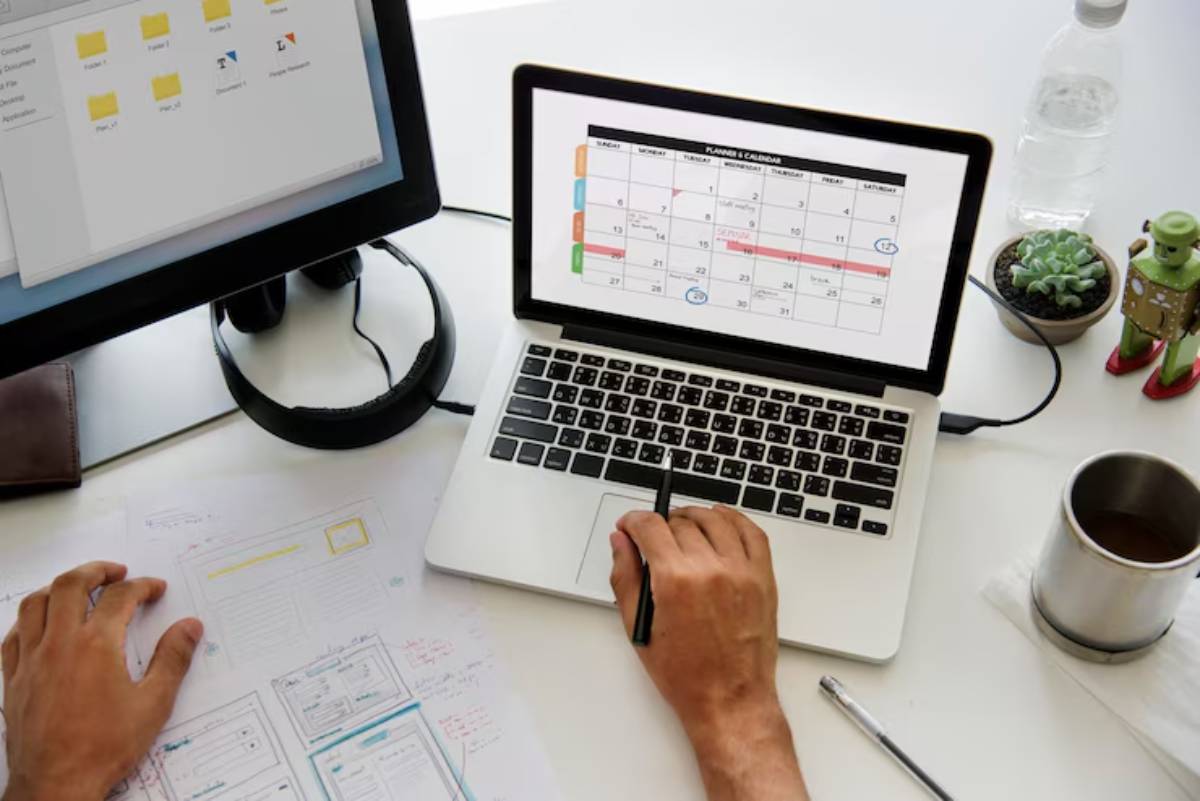
Time Blocking for Remote Workers
Working from home sounds like a dream—no commute, comfy clothes, freedom over your schedule. But without a solid structure, that dream can quickly turn into a productivity nightmare. Suddenly, you’re answering emails in your pyjamas at 10 p.m., your work bleeds into your weekends, and your to-do list never seems to shrink.
The solution? Time blocking. If you’re juggling deadlines, distractions, and Zoom calls from your kitchen table, creating a personalised remote time management strategy is essential. By combining a digital schedule planner with consistent WFH routines, you can restore your work-life balance, boost productivity, and actually enjoy the perks of remote work.
In this guide, we’ll walk you through everything you need to know to use time blocking effectively as a remote worker. We’ll cover structure, flexibility, tools, examples, and practical hacks to help you design your ideal day.

Why Remote Workers Need Time Blocking
1. Blurred Boundaries
When your living room is your office, it’s hard to “clock out.” Time blocking defines your start and stop times, so your work doesn’t consume your personal life.
2. Distractions at Home
Laundry, kids, deliveries, social media—they’re all competing for your attention. A blocked calendar helps you stay focused on one task at a time.
3. Asynchronous Collaboration
Your teammates might be in different time zones. Time blocking ensures you reserve slots for both independent work and team engagement.
4. Lack of Structure
Without office hours, meetings, or lunch breaks to guide your day, it’s easy to drift. Time blocking gives you a visual plan to follow.
What Is Time Blocking?
Time blocking is a scheduling method where you allocate specific blocks of time for tasks, rather than working from a to-do list. It helps you:
- Plan your day in advance
- Assign time to both work and personal activities
- Focus without multitasking
Want the basics? Start with What Is Time Blocking and Why It Works.
Key Benefits for Remote Professionals
- Clear expectations: You know what to work on and when
- Work-life balance: Personal time gets blocked in, too
- Increased focus: One task at a time, with fewer distractions
- Better collaboration: Teammates know when you’re available

How to Build a Time Blocking Routine for WFH Success
1: Identify Your Core Responsibilities
Every role has its main buckets. For remote workers, this might include:
- Deep Work (coding, writing, designing)
- Communication (Slack, Zoom, email)
- Admin (timesheets, billing, updates)
- Collaboration (meetings, brainstorming)
- Breaks and personal time (very important!)
2: Track Your Time for One Week
You can’t improve what you don’t measure. Use tools like Toggl or RescueTime to understand where your hours go.
3: Map Your Energy Patterns
When do you feel most focused? For most people:
- Mornings = best for deep work
- Afternoons = good for meetings
- Evenings = creative or wrap-up tasks
4: Draft Your Daily Template
Here’s an example remote worker time block:
- 7:30–8:00 AM: Morning routine (meditation, breakfast)
- 8:00–8:30 AM: Daily planning + inbox
- 8:30–10:30 AM: Deep Work Block
- 10:30–11:00 AM: Break (walk, coffee)
- 11:00 AM–12:30 PM: Meetings / Collaboration
- 12:30–1:30 PM: Lunch + screen break
- 1:30–2:30 PM: Admin / Communication block
- 2:30–4:00 PM: Secondary Focus Block
- 4:00–4:30 PM: Wrap-up + Tomorrow Planning
Don’t forget to schedule breaks, buffers, and downtime.

Weekly Themes to Reduce Decision Fatigue
Assigning daily themes simplifies planning:
- Monday: Planning + Admin
- Tuesday: Deep Project Work
- Wednesday: Team Collaboration
- Thursday: Focus + Strategy
- Friday: Review + Learning
This also helps others know when you’re best available.
Tools for Digital Schedule Planning
Calendar Apps
- Google Calendar: Set recurring blocks, colour code tasks
- Outlook: Integrated with Teams and email
- Fantastical: Ideal for Apple users with multiple calendars
Planning & Automation Tools
- Sunsama: Aligns tasks with time blocks daily
- Motion: AI reschedules tasks based on meetings
- Clockwise: Optimises team availability for meetings
Task Managers
- Trello: Great for visual task boards
- Asana: Integrate tasks with calendar views
- Notion: Build a custom dashboard that syncs with your calendar
Tips to Make Time Blocking Stick
1. Use Visual Cues
Colour-code tasks based on energy type:
- Deep Work = Blue
- Admin = Grey
- Communication = Yellow
- Breaks = Green
2. Leave Flex Space
Don’t block every minute. Include buffers for unexpected delays or inspiration.
3. Protect Deep Work
Use “Do Not Disturb” mode. Turn off notifications. Block your calendar.
4. Review Weekly
Every Friday, ask:
- What blocks worked?
- Which ones felt rushed?
- What do I want to change next week?
5. Communicate Your Availability
Let your team know when you’re in meetings, heads-down, or off.
Real-Life Example: David the Remote Marketing Consultant
David used to feel like he was always working but never accomplishing much. His inbox ruled his day. Meetings were scattered.
After switching to time blocking:
- 8:30–10:30 AM: Deep Work for client strategy
- 11:00 AM–12:30 PM: Collaborative calls
- 2:00–3:00 PM: Admin and emails
Results:
- Productivity improved by 40%
- Fewer missed deadlines
- More evenings spent with family
“Time blocking gave me back my evenings,” he says.
Common Concerns About Time Blocking Remotely
What if I don’t finish everything in a block? Move it to the next available block. That’s why buffers matter.
How do I avoid over-planning? Start with 60% of your day blocked. Leave the rest for spontaneity.
Can I combine time blocking with other productivity systems? Absolutely. It complements GTD, Pomodoro, and task batching.
Conclusion: Bring Structure and Sanity to Remote Work
Remote work can be freeing—but only if you learn to manage your time with intention. By using time blocking, you give your day purpose, clarity, and space.
Whether you’re juggling projects across time zones or just trying to separate your work from your sofa, a remote time management system rooted in digital schedule planning and reliable WFH routines is your best tool.
Try blocking your next workday right now. Start with three core blocks and see how it feels.
For more structure, explore how to build your ideal week using theme-based time blocking.


